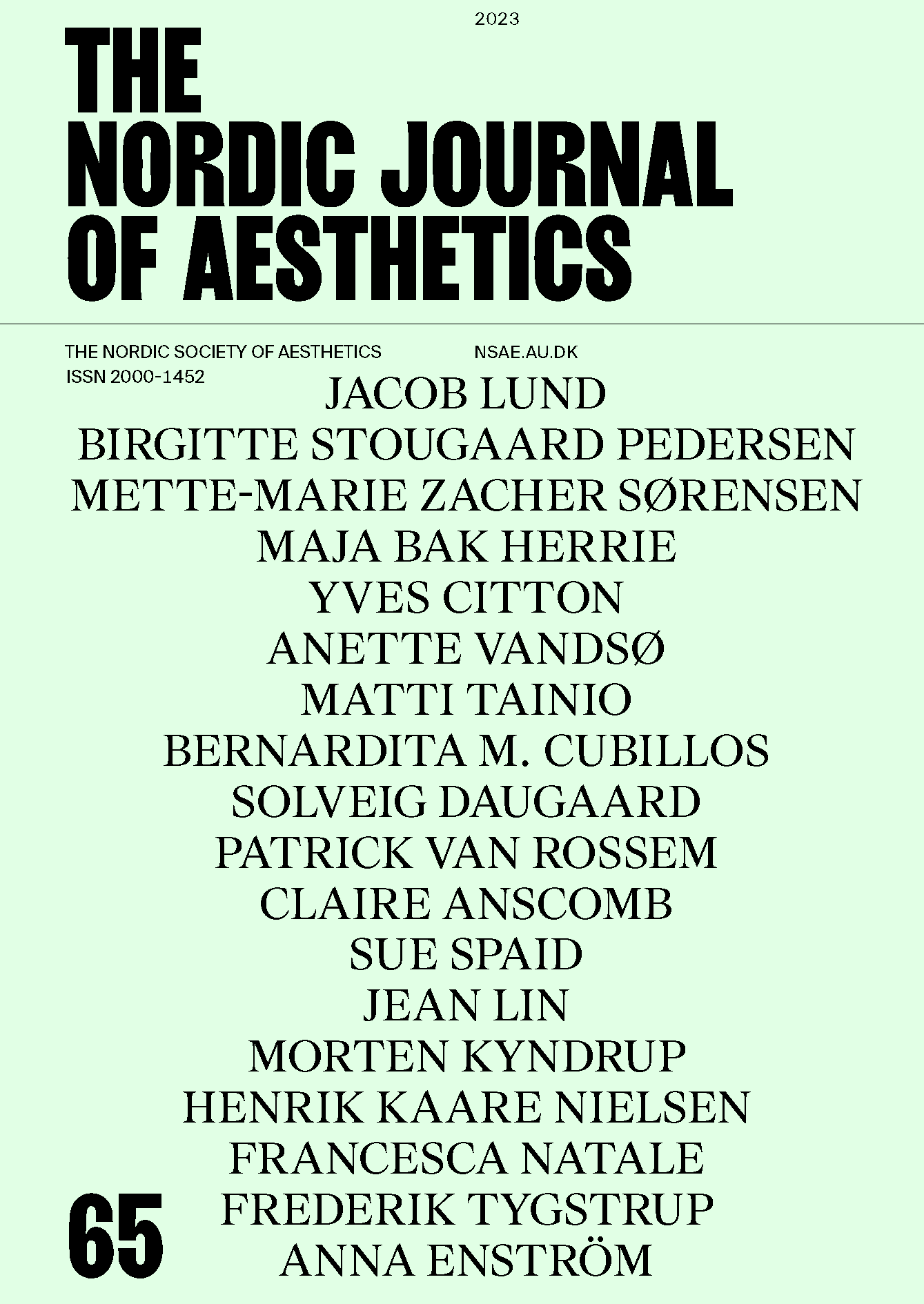On the Performativity of Disinterested Attention for the Experience of Contemporary Art
DOI:
https://doi.org/10.7146/nja.v32i65-66.140114Keywords:
Disinterestedness, Free-floating Attention, Contemplation,, Contemporary ArtAbstract
The aim of this article is to point out that attentional practices don’t simply overlap with control and action/reaction dynamics; they are also strictly connected to non-productivity, non-instrumentality, disinterestedness, contemplation as performative inactivity. Disinterested attention (a definition formulated by Bence Nanay) and free-floating attention help to better understand the apparently seamless and unproblematic transition from passive spectator to active participant/agent of contemporary art. If considering attention in relation to executive functions (planning and organizing our experience in the world we live in) could be persuasive, a self-evident definition of attention strictly considered as “selection for action” is less convincing, and the weakness of this connection becomes clear when goal-oriented attitude is pushed into the background. Attention is often researched into to improve our performances and to overcome the inevitable “blind spots”: experiencing art is about a different way of paying attention, that is fluctuating, “suspended,” fragmented.
References
Emilio Garroni, Estetica ed Epistemologia: riflessioni sulla Critica del Giudizio (Roma: Bulzoni, 1967).
Emilio Garroni, Immagine Linguaggio Figura, (Roma-Bari: Laterza, 2005).
Byung-Chul Han, The Burnout Society, translated by Erik Butler (Stanford: Stanford University Press, 2015).
Wayne Wu, “Attention as Selection for Action,” in Attention: Philosophical and Psychological Essays,
edited by Christopher Mole, Declan Smithies & Wayne Wu (Oxford University Press, 2011), 97–116.
Winifred Gallagher, Rapt. Attention and the Focused Life (New York: The Penguin Press, 2009).
Cathy N Davidson, Now You See It. How the Brain Science of Attention Will Transform the Way We Live, Work and Learn (New York: Viking, 2011).
Jonathan Crary, Suspensions of Perception: Attention, Spectacle and Modern Culture (Cambridge, MA: MIT Press, 1999), 348–349, https://doi.org/10.7551/mitpress/6569.001.0001.
Alva Noë, Strange Tools. Art and Human Nature (New York: Hill and Wang, 2015).
Bence Nanay, Aesthetics as Philosophy of Perception (Oxford: Oxford University Press, 2016), 24, https://doi.org/10.1093/acprof:oso/9780199658442.001.0001.
Yves Citton, The Ecology of Attention (Cambridge: Polity Press, 2017).
André Lepecki, Singularities. Dance in the Age of Performance (New York: Routledge, 2016).
Yves Citton: “Attention Agency is Environmental Agency”, Communication in the Age of Attention Scarcity. Edited by Waddick Doyle & Claudia Roda. Chalm (London: Palgrave Macmillan, 2019), 21–32, https://doi.org/10.1007/978–3-030-20918-6_3.
Richard Schechner, “Selective Inattention: A Traditional Way of Spectating Now Part of the Avant-Garde,” Performing Arts Journal 1, no. 1 (1976): 8–19, https://doi.org/10.2307/3245182.
Jacques Rancière, Le spectateur émancipé (Paris: La Fabrique éditions, 2008).
Crary, Suspensions of Perception, 47, https://doi.org/10.3917/lafab.ranci.2008.01.
Claire Bishop, “Black Box, White Cube, Gray Zone: Dance Exhibitions and Audience Attention,” The Drama Review 62, no. 2 (Summer 2018): 22–42, https://doi.org/10.1162/DRAM_a_00746.
Downloads
Published
How to Cite
Issue
Section
License
Copyright (c) 2023 Francesca Natale

This work is licensed under a Creative Commons Attribution 4.0 International License.
Authors who publish with this journal agree to the following terms:
- Authors retain copyright and grant the journal right of first publication with the work simultaneously licensed under a Creative Commons Attribution License that allows others to share the work with an acknowledgement of the work's authorship and initial publication in this journal.
- Authors are able to enter into separate, additional contractual arrangements for the non-exclusive distribution of the journal's published version of the work (e.g., post it to an institutional repository or publish it in a book), with an acknowledgement of its initial publication in this journal.
- Authors are permitted and encouraged to post their work online (e.g., in institutional repositories or on their website) prior to and during the submission process, as it can lead to productive exchanges, as well as earlier and greater citation of published work (See The Effect of Open Access).




